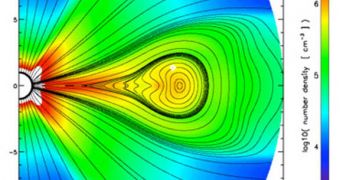As our Sun is beginning to wake up from its prolonged period of solar minimum, researchers are again starting to take interest in the possible effects that this awakening may have on our planet. Earth itself is at no risk from these outbursts of hot, ionized gas from the star, but everything that operates with electricity is. Understanding the nature of coronal mass ejections (CME), and also that of the other phenomena associated with it, might help scientists devise better methods of taking care of Earth's satellites and power grids.
In addition, astrophysicists may learn more about the intricate phenomena going on inside the Sun, just under its surface. These mechanisms are the ones that promote the formation of these CME, which can have numerous “side-effects.” Some of these associated events include solar flares, eruptive prominences, coronal waves and post-eruptive arcades. Most of these phenomena in turn trigger the release of various forms of radiation, which are then spread throughout the solar system. Naturally, some of them also hit our planet, PhysOrg reports.
Fortunately, Earth is surrounded by a protective shield of sorts, a layer of the atmosphere called the magnetosphere. Its main role is to deflect incoming solar radiation, but the problem is that it does not protect our satellites, and the International Space Station (ISS). Given how much we rely on satellite communications, transmissions, and that six astronauts permanently inhabit the ISS, it stands to reason that losing our orbital capabilities would have far-reaching consequences. This is why predicting space weather has become so important over the past few years.
A new CME study is currently being carried out by a team of physicists at the US Naval Research Laboratory's (NRL) Space Science Division. The group wants to learn more about potential spacecraft anomalies and communication interruptions that events associated with CME might trigger. Establishing the composition of the ejections is one of the most important steps. Physicists say that this knowledge could help us determine how the events occur, and also how they propagate through interplanetary space.

 14 DAY TRIAL //
14 DAY TRIAL //